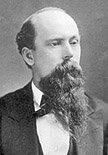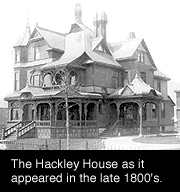 Charles Henry Hackley Charles Henry Hackley, Muskegons philanthropist and entrepreneur, whose gifts and services to Muskegon made possible the transition from a lumber town to a city of diverse industry, was a product of the lumber era and owed his fortune to the lumber industry.
Mr. Hackley was born on January 3, 1837, at Michigan City, Indiana, the eldest of five children. He had two brothers and two sisters. While he was still an infant, his family moved to Kenosha, Wisconsin, where he received his education. His family was of modest means and Charles worked and went to school for equal amounts of time. At the age of fifteen, he left school to work for his father, a road contractor. He and the cre
|
Hackley helped Muskegon transition from a lumber town to a city of diverse industry.
|
w of which he was in charge did all of the repair and maintenance of twenty miles of plank road. Charles was only sixteen.
Charles Hackleys father, Joseph, had often been unable to find work as a carpenter and soon heard of the many jobs available in Michigan in the lumber industry. After going to Muskegon and working for a year there, he wrote to Charles, suggesting that Charles join him.
On April 17, 1856, Charles arrived at Muskegon on the schooner Challenge, having worked his passage across Lake Michigan. He was employed that same day by the firm of Durkee, Truesdell and company as a laborer. The agreement with Charles was that he would be paid according to the value of his services. When paid, he received $22 a month, above average for the time. Shortly, his pay increased to $25 per month.
In the fall, the mill shut down as the supply of wood had been exhausted. Charles got work with the same firm as a scaler, earning $30 per month. He spent that winter in the woods, learning about Michigan timber land and its commercial possibilities as well as learning about the various jobs in the forest.
Returning to Muskegon in the spring, Charles reputation was so good that the company made him the foreman in charge of the crews that cleared the mill and piled the lumber as it came from the saws.
In 1857, a general business depression occurred throughout the United States and Muskegon was affected. The mills were closed and logging was mostly stopped. Charles employer, recognizing his abilities, suggested
that he improve himself and get some business training. He returned to Kenosha, Wisconsin, and enrolled in the business college there. It was understood that when he returned to Muskegon, he would be given a job in the office and made a bookkeeper. Charles completed his studies and returned to Muskegon only to find that the company was unable to survive the depression and was sold. The property was purchased by Gideon Truesdell. Charles was hired by him for $30 per month.
This experience taught Charles that ownership held no more hazard than being an employee and that his real future depended upon his going into business for himself.
In the spring of 1859, Charles, then 22 years old, persuaded his father and Mr. Truesdell to join him in purchasing the mill property of Pomeroy and Holmes Company which had failed. The firm of J.H. Hackley was formed. After two years of success, the mill expanded by purchasing the Wing mill. Charles kept the books for the two mills as well as the records for Mr. Truesdell.
|



 Charles Henry Hackley, Muskegons philanthropist and entrepreneur, whose gifts and services to Muskegon made possible the transition from a lumber town to a city of diverse industry, was a product of the lumber era and owed his fortune to the lumber industry.
Charles Henry Hackley, Muskegons philanthropist and entrepreneur, whose gifts and services to Muskegon made possible the transition from a lumber town to a city of diverse industry, was a product of the lumber era and owed his fortune to the lumber industry.
